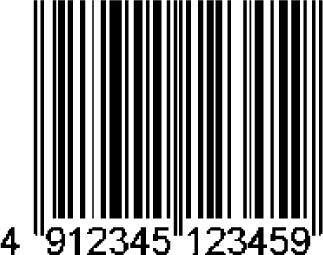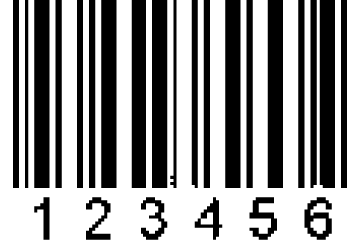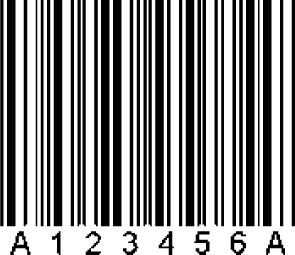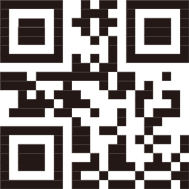Things That Handheld Computers Can Read
Handheld computers are specialized mobile terminals that can read data by using a built-in laser scanning module or a specialized camera to sense differences in the thickness of the bars (lines) and spaces of barcodes. This section explains information such as the types of barcodes that handheld computers can handle and the differences between these barcodes.
Barcodes and 2D Codes
Barcodes are the most popular codes. They are affixed to products in supermarkets and convenience stores. Wide lines, thin lines, and spaces are arranged in a striped pattern.
The typical 2D code is the QR code. It consists of small dots and spaces arranged in a compact, square area. Their use has spread rapidly because they can be read by cameras on mobile phones. In addition to QR codes, stacked codes, in which multiple barcodes are stacked on top of each other, are another commonly known type of 2D code. Because QR codes are constructed by arranging small squares vertically and horizontally, they are also called matrix codes.
Types of Codes That Can Be Read
There are over 100 barcode standards in the world. This section introduces typical barcodes and explains their characteristics.
EAN/JAN/UPC

- Characteristics
- EAN is an internationally common product code that is compatible with JIS in Japan and UPC in the United States and Canada.
- Types of characters that can be handled
- Numbers from 0 to 9
- Number of digits that can be expressed
- 13 digits or 8 digits
- Application examples
- A wide range including daily necessities, books, magazines, consumer electronics, and clothing
ITF

- Characteristics
- This is the standard logistics code that is printed on cardboard boxes. Five bars express one character. It has the advantage of being able to express the same number of digits in a smaller space than required by other codes.
- Types of characters that can be handled
- Numbers from 0 to 9
- Number of digits that can be expressed
- Even numbers of digits only
- Application examples
- Logistics products
CODE39

- Characteristics
- In this barcode standard, one character is expressed with five bars and four spaces. Compared to ITF and NW-7 (which will be explained later), a wider barcode is required to express the same number of digits, but this leads to a corresponding increase in reading accuracy. An additional advantage is that the number of digits that can be expressed can be set arbitrarily.
- Types of characters that can be handled
-
- Numbers from 0 to 9
- Uppercase alphabet characters
- Symbols (-, ., space, $, /, +, and %)
- Asterisks (*, which is used as a start/stop character)
- Number of digits that can be expressed
- Arbitrary
- Application examples
- Factory use (such as in the automotive industry)
CODE128

- Characteristics
- The 128 ASCII code characters can be expressed. There are three types of bars, and one character is expressed with three bars and three spaces. Not only is it possible to handle a wide variety of types of characters, but the code can be expressed in a more compact manner than other codes when expressing just numbers (however, this refers to when expressing 12 or more digits).
- Types of characters that can be handled
-
- All ASCII code characters
- Numbers from 0 to 9
- Uppercase and lowercase alphabet characters
- Symbols
- Control characters (such as CR and STX)
- Number of digits that can be expressed
- Arbitrary
- Application examples
-
- Chain stores and department store associations
- Medical materials industry
- Convenience store industry
- Meat industry
NW-7 (Codabar)

- Characteristics
- There are two bar sizes, and one character is expressed with four bars and three spaces. This barcode type is referred to as NW-7 or Codabar. Alphabet characters a to d are used for the start character that indicates the point to start reading the code and the stop character that indicates the point to stop reading the code. The structure is simple and enables the expression of only numbers and some symbols.
- Types of characters that can be handled
-
- Numbers from 0 to 9
- Symbols (-, $, /, ., and +)
- Alphabet characters from a to d (start/stop characters)
- Number of digits that can be expressed
- Arbitrary
- Application examples
-
- Home delivery slips
- Development, printing, and enlargement (printing shops)
- Lending management at libraries
QR

- Characteristics
- QR is an abbreviation of Quick Response, meaning that these codes can be read at high speed. Also, because dots are arranged vertically and horizontally, the amount of information that can be stored is large. This gives QR codes the characteristic of being able to handle not just numbers but various languages. Because QR codes are constructed by arranging small squares vertically and horizontally, they are also called matrix codes.
- Types of characters that can be handled
-
- Numbers from 0 to 9
- Uppercase and lowercase alphabet characters
- Symbols
- Various languages including Japanese kanji
- Number of digits that can be expressed
- Arbitrary
- Application examples
-
- Inventory management (such as in warehouses)
- Medical worksites
- Receiving lockers (at airports)
- Corporate campaigns
DataMatrix

- Characteristics
- DataMatrix is a matrix 2D code that was developed by ID Matrix in 1987. It was registered as the AIMI ISS standard in 1996 and became an ISO/IEC standard in 2000. Older versions of DataMatrix code include ECC000, ECC050, ECC080, ECC100, and ECC140. ECC200 is the latest version of DataMatrix code. The old versions are not resistant to distortion, and the ECC200 version is currently used because it has an improved error correction function for handling distortion. There are two types of DataMatrix codes: a square configuration and a rectangular configuration. There are 24 symbol sizes (6 for the rectangular configuration) ranging from 10 × 10 modules to 144 × 144 modules. When the symbol size is 26 × 26 modules or larger (there are 24 × 24 data modules or more), the symbol is divided into blocks so that each data cell is less than 24 × 24 modules. This increases the resistance against distortion.
- Types of characters that can be handled
-
- Numbers from 0 to 9
- Uppercase and lowercase alphabet characters
- Symbols
- Various languages including Japanese kanji
- Number of digits that can be expressed
- Arbitrary
- Application examples
-
- Medicine and medical products
- Surgical instruments such as scalpels and scissors
- Marking on semiconductors and similar parts
- History management (traceability) of compact parts
PDF417

- A: Start pattern
- B: Left row indicator
- C: Datawords (1 to 30)
- D: Right row indicator
- E: Stop pattern
- Characteristics
- PDF417 is a multi-row (stacked) 2D code developed in 1989 by Symbol Technologies. It was registered as the AIMI USS standard in 1994 and became an ISO/IEC standard in 2000. It was also standardized as JIS X0508:2010 in March 2010. The maximum data size is 1850 alphanumeric characters, 2725 numeric characters, and 1108 binary bytes. This makes it possible to encode items including Japanese kanji, figures, images, and audio. Symbols consist of a continuous (stacked) set of levels ranging from 3 to 90 levels. Symbols are composed of start and stop patterns, left and right level indicators, and 1 to 30 symbol characters. Variants of this code also exist. Examples include Compact PDF417 (Truncated PDF417/truncation mode), in which the right row indicators are omitted and the stop pattern is reduced, and MicroPDF417, which is based on PDF417 but has the start and stop codes simplified and the height of each module doubled so as to enhance the data density and save space.
- Types of characters that can be handled
-
- Numbers from 0 to 9
- Uppercase and lowercase alphabet characters
- Symbols
- Various languages including Japanese kanji
- Number of digits that can be expressed
- Arbitrary
- Application examples
-
- Shipping specifications
- Quality management and production instructions
- ID cards such as licenses
- Electronic postage stamps




